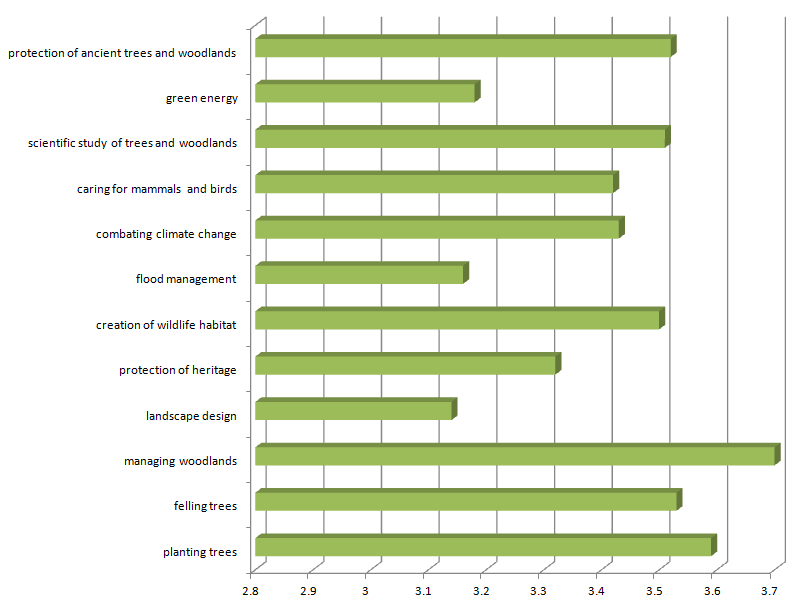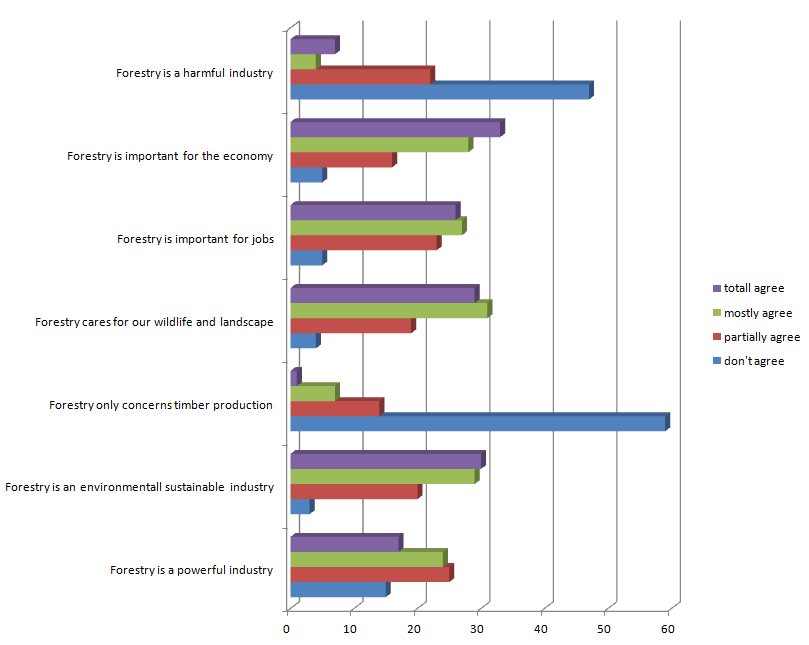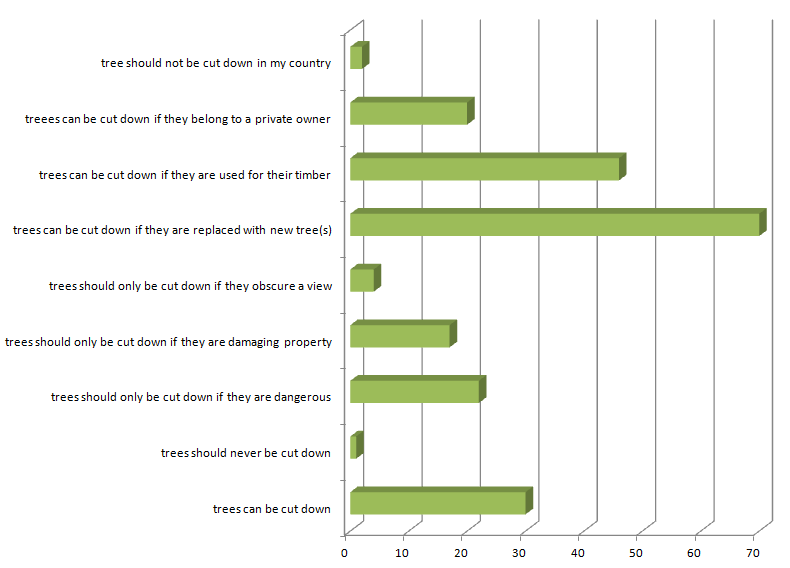I conducted a small online survey concerning public attitudes to trees and wood over the Christmas period (December 2011 – January 2012). I collected 83 responses to the survey, which I designed using Survey Monkey. I am the first to admit that the survey had some shortcomings in design, in that my lack of understanding of social sciences and in questionnaire design, probably led to some curious phrasing. Nonetheless I think that the results make for interesting reading.
My intention was to explore some of the deeper public attitudes to forestry as an industry; what people perceive it to be about, its importance and power. I also asked questions relating to the importance and prominence of wood in people’s lives today.
The questions emerged from some of my personal everyday experiences as a forester in talking and working with members of the public. For instance I have held conversations with a number of people who have felt that trees should never be cut down in any circumstances, and that it is quite possible for wood to be harvested from trees that have died naturally. Question 10 confirms that this view does exist although it is held by a rare minority. Clearly this is a view that demonstrates a disconnection from the realities of the amount and importance of timber in our everyday lives (Q5 & Q6), and that the needs of modern society could never be amassed from unmanaged forests alone. It is also, perhaps, prejudiced by a view that forests cannot be managed sustainably and that forestry is a powerful and harmful industry (Q9).
I explored in Question 8 what activities people thought ‘forestry’ concerned. I was very surprised that 23% of respondents thought that it had little or no relevance to green energy. Within the sector, the emerging opportunities for wood heat and energy are driving forestry policies and seen as the economic saviour for struggling woodland owners. Yet externally it is seen as irrelevant by many. Quite a large proportion of respondents also thought that forestry was not particularly relevant to flood management (e.g. planting trees in water catchments, reducing bank erosion) or climate change (e.g. reducing heating/cooling needs in cities, providing habitat for displaced species). The examples here are my own and were not included in the survey. A lack of appreciation by respondents for the diverse benefits arising from sustainable forest management is the main message here.
I also wanted to explore a fundamental area that I have written about before on this blog and spoken about publicly; namely the concept that cutting down trees is seen as a bad thing, even though wood is commonplace for all of us in modern society (e.g. The Art & Joy of Wood). I have drawn comparisons between farming animals for meat (shrink-wrapped supermarket meat and the idea that it was once part of a living animal), and forestry and the concept that we surround ourselves with wood in our homes and workplaces yet object to the concept of felling a tree for its wood. I have referred to this using the term nature deficit disorder. I am not sure that I have been successful in teasing out any data on this here so I may need to return to this area in the future.
Gabriel Hemery
Summary results for the 10 questions
Question 1: In what country do you live?
The majority of respondents (77%) were from the UK.

Question 2: Are you male or female?
There was a fairly even split between the number of respondents being male (58%) and female (42%).

Question 3: What category is your age?
Most respondents were aged between 50-59 (N=24), followed by those between 40-49 (N=20). Only 3 respondents were 29 years of age or less. 17 respondents were over 60 years of age.

Question 4: Have you ever worked in any of the following professions or consider yourself an expert in any of the following subjects?
53% (N-44) of respondents did not consider themselves to be experts or to have relevant professional experience in a number of related subjects. Among those who did consider themselves experts, 16% cited forestry, followed by 6% in arboriculture. No respondents cited wood technology experience.

Question 5: How important do you think wood is to modern life?
88% of respondents believed that wood is very important to modern life; the remaining 18% believing it is quite important.

Question 6: How much wood is there in your life?
This question explored the presence of wood in people’s homes and workplaces. Very few respondents had woodchip boilers at their workplace (N=2) or home (N=4). Most respondents recognised the importance of paper and furniture. Some additional responses to this question included: rustic use in properties, timber-framed roofing, wooden beehives, guitars, carvings, cooking fuel and packaging materials.

Question 7: When were you last in a woodland?
The majority of respondents (47%) had last visited a woodland within a week. Two respondents had never visited a woodland. One respondent added that they lived in a wood.

Question 8: How strongly do you think the following activities are part of Forestry?
This question provoked some complaints from respondents in that Forestry was not defined. Indeed it was not defined but this was deliberate as I was seeking to explore what people believed forestry was about. The activities thought to be least part of forestry were landscape design, followed by flood management and green energy.
I explored these data further by filtering responses from experts and non-experts (Question 4). Of the 18 respondents who cited flood management as being rarely or never part of forestry, 10 were experts. Of the 19 respondents (23%) who cited green energy as being rarely or never part of forestry, 8 were experts.
Nine respondents (3 were experts) cited climate change as being rarely (N=5) or never (N=4) part of forestry.

Question 9: How strongly to you agree with the following statements about Forestry?
In line with Q8 some respondents complained about the lack of a definition for Forestry. The strongest disagreement concerned the statement that Forestry only concerns timber production. The statement that Forestry is a powerful industry was most contentious, in terms of similarity of responses (15 didn’t agree/17 totally agreed).
I explored further the question concerning whether respondents considered forestry to be an Environmentally Sustainable Industry. There were no significant differences in the responses from Non-experts and Experts (Q4) with both categories having 10 respondents answering Partially, and 2 and 1 respectively answering Don’t agree.

Question 10: Which of the following statements about tree felling do you agree with?
Most respondents agreed with the statement that Trees can be cut down if they are replaced with new tree(s). One respondent answered that Trees should never be cut down, and 2 respondents answered that Trees should not be cut down in my country.

 This work is licensed under a Creative Commons Attribution- NonCommercial- NoDerivs 3.0 United States License.
This work is licensed under a Creative Commons Attribution- NonCommercial- NoDerivs 3.0 United States License.
